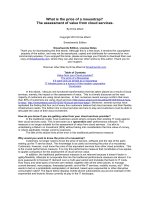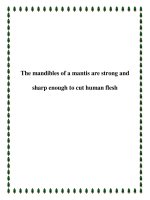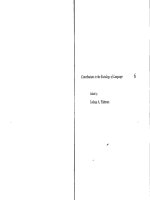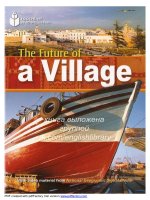4 3 5 the price of a pipeline (social studies)
Bạn đang xem bản rút gọn của tài liệu. Xem và tải ngay bản đầy đủ của tài liệu tại đây (8.44 MB, 14 trang )
Suggested levels for Guided Reading, DRA,™
Lexile,® and Reading Recovery™ are provided
in the Pearson Scott Foresman Leveling Guide.
Pr ice
Pipeline
The
Genre
Expository
nonfiction
Comprehension
Skills and Strategy
• Generalize
• Sequence
• Text Structure
Text Features
• Heads
• Map
• Captions
Scott Foresman Reading Street 4.3.5
BY
ISBN 0-328-13456-2
ì<(sk$m)=bdefge< +^-Ä-U-Ä-U
of a
BENJ AMIN L AZARUS
Reader Response
Pr ice
Pipeline
The
1. Based on what you have just read, would you say
the Trans-Alaska Pipeline was a simple project
or a complicated project? Give reasons for your
answer. Use a graphic organizer like the one
below to help organize your thoughts.
of a
Main Idea
Supporting
Details
2. How does the early section on “Alaska’s
BY B
ENJ AMIN
AZARUS
Environment”
prepare
youLfor
the later sections
on the impacts of the pipeline?
3. Copy these words on your paper: disastrous,
famous, joyous, mysterious, nervous, vigorous,
and wondrous. After each word, write the base
word, without the suffix. (Remember, some
words have changes of spelling when suffixes
are added.) Finally, write the suffix and what you
think it means.
4. Look at the two food chains on page 15. How
does each one show that plants and animals are
interconnected?
Editorial Offices: Glenview, Illinois • Parsippany, New Jersey • New York, New York
Sales Offices: Needham, Massachusetts • Duluth, Georgia • Glenview, Illinois
Coppell, Texas • Ontario, California • Mesa, Arizona
OIL !
Every effort has been made to secure permission and provide appropriate credit for
photographic material. The publisher deeply regrets any omission and pledges to
correct errors called to its attention in subsequent editions.
Unless otherwise acknowledged, all photographs are the property of Scott Foresman,
a division of Pearson Education.
Photo locators denoted as follows: Top (T), Center (C), Bottom (B), Left (L), Right (R),
Background (Bkgd)
Cover: ©Karen Kasmauski/Corbis; 1 © Joel W. Rogers/Corbis; 3 © Kimberly White/
Reuters/Corbis; 4 ©Bettmann/Corbis; 6–7 © Staffan Widstrand/Corbis; 8 © Bettmann/
Corbis; 9 ©Joel W. Rogers/Corbis; 10 © Galen Rowell/Corbis; 11 © Galen Rowell/Corbis;
12–13 ©Dan Guravich/Corbis; 14–15 © Kennan Ward/Corbis; 16–17 © Paul A. Souders/
Corbis; 18 ©Galen Rowell/Corbis; 19 © Lloyd Cluff/Corbis; 20–21 © Natalie Fobes/Corbis
ISBN: 0-328-13456-2
Copyright © Pearson Education, Inc.
All Rights Reserved. Printed in the United States of America. This publication is
protected by Copyright, and permission should be obtained from the publisher
prior to any prohibited reproduction, storage in a retrieval system, or transmission
in any form by any means, electronic, mechanical, photocopying, recording, or
likewise. For information regarding permission(s), write to: Permissions Department,
Scott Foresman, 1900 East Lake Avenue, Glenview, Illinois 60025.
2 3 4 5 6 7 8 9 10 V0G1 14 13 12 11 10 09 08 07 06 05
Without oil, we could not live as we
do. Oil fuels most cars, trucks, buses,
boats, trains, and planes. It fuels machines
in factories. It heats homes, offices, and
schools. Oil is used to make products such
as ink, crayons, bubble gum, dishwashing
liquids, ammonia, deodorant, eyeglasses,
phonograph records,
and tires.
In 2003, the
United States used
375.3 million gallons
of oil a day for
transportation and
.468 million gallons
of oil a day for
other purposes. But
the United States
produces only 44% of the oil it uses. The
rest is imported from other countries.
Importing oil from other countries
is expensive. It’s also risky. If there are
problems in an oil-producing region, oil
supplies can shrink and prices can climb.
So American oil companies are always
looking for ways to supply their own
oil. They set up drilling sites all over the
country to look for this valuable resource.
3
The pipeline promised to
solve America’s oil problem.
In 1968, oil companies discovered an
enormous field of oil at Prudhoe Bay, on the
northern coast of Alaska. Prudhoe Bay is above
the Arctic Circle. It’s far too remote for most
forms of transportation. How would the oil
companies get the oil to the rest of the United
States?
T HE P IPELINE
The answer was a pipeline. It would have to
transport the oil 800 miles, to the port of Valdez.
Valdez, though far south in the Gulf of Alaska,
was the nearest ice-free port. There, oil could be
loaded onto tankers and shipped to the rest of
the United States.
Oil companies rushed to create a plan. They
faced many challenges: They had to construct a
pipe system to withstand the dramatic Alaskan
climate, as well as Alaska’s earthquakes. Oil
would need to flow freely through the pipe.
Since oil comes out of the ground hot, the heat
generated in the pipe would need to be spread
out. Heated pipes could harm the permafrost—
a permanently frozen layer just below the
surface of the ground. The oil companies were
worried that if the permafrost melted, it could
cause the pipe to sink and possibly break. The
port of Valdez also had to be turned into a major
shipping zone, capable of handling giant oil
tankers.
4
5
E NVIRONMENTAL R ISKS
But the idea of a pipeline crossing Alaska
raised many questions. Some scientists and
wildlife experts were concerned about the
environment. They disagreed with the oil
companies, believing that the impact of melted
permafrost on a pipe was not the point. For
them, the point was the danger of damaging the
permafrost itself. Alaska’s environment is fragile
and interconnected. It sustains many forms of
life. These, in turn, support and sustain each
other. So harming one part of the environment
could cause major damage to other parts.
Some environmental experts asked what
would happen to this special world if there were
an accident. What damage would an oil spill
do? What about the effects of roads and trucks?
Some people believed the enormous construction
project was simply too much for the Alaskan
environment.
6
Others, however, believed the pipeline was a
terrific idea with little risk. They argued that the
pipe would be well constructed and the chance
of accidents would be extremely low. They
believed that the effects of roads and trucks on
the land would be minor. Finally, they argued
that the tremendous benefits to the entire
country greatly outweighed any possible risks.
In 1970, people fought to halt the project
with a series of lawsuits. They argued that the
pipeline would have lasting effects on Alaska’s
environment. They requested that the oil
companies find less destructive ways to transport
the oil.
But the oil companies insisted that they could
make sure the pipeline was harmless. They
argued that every day spent trying to halt the
pipeline was costing the United States millions in
foreign oil payments.
The environmentalists lost. In 1973, President
Richard M. Nixon signed the Trans-Alaska
Pipeline Authorization Act. By 1974, construction
was underway.
7
C ONSTRUCTION
When it was built, the pipeline was the
most expensive, privately funded project of its
kind. It cost 8 billion dollars. Creating a marine
terminal at the port of Valdez cost $1.4 billion.
Creating the pipeline required five separate
contracting companies and a crew of 21,000
people. Twenty-nine
temporary camps were
built. Three million tons
of material were shipped
to the construction sites.
Fourteen airfields were
built to transport crew
and materials.
The pipe itself is steel
and measures 48 inches in
diameter. It is built in six separate sections that,
when connected, run 799 miles from northern
to southern Alaska. It crosses three mountain
ranges and more than 800 rivers and streams.
Some parts are buried underground.
Engineers worked to find solutions to the
challenges of placing the pipeline in the Alaskan
climate. The pipeline is built in a zig-zag so it
can naturally expand and contract, depending
on outside temperatures. To keep oil moving,
12 pumping stations were built along the
pipeline. To help prevent the oil’s heat from
melting the permafrost, radiators to spread the
heat out were installed.
8
The pipeline was finally completed in June
1977. That August, oil began to flow. The first
tanker to ship pipeline oil from the port of
Valdez was the ARCO Juneau. Since then, some
16,000 tankers have been filled at Valdez, and
more than 13 billion barrels of oil have traveled
through the pipeline. Daily, the pipeline can
transport up to 2.1 million barrels. That’s a lot
of oil.
But were the oil companies right? Has the
pipeline been a success with minimal damage to
the environment? Or were the environmentalists
right? Were Alaska’s landscape and wildlife
harmed? Was the Alaskan environment changed
forever?
What would the
pipeline do to the
untouched beauty of
the Alaskan tundra?
9
Top layer
of soil,
permafrost
Dangerous
gases are
frozen.
Winters on the Alaskan tundra are
long, and summers are short. But
animals that live there have adapted
to its environment. In fact, it would
be harder for them if conditions
change.
A LASKA ’ S E NVIRONMENT
To understand the relationship between
the pipeline and the Alaskan environment, it’s
important to understand what makes Alaska
so unique.
Alaska is an enormous state. At its widest
points, it measures 1,400 miles from north to
south and 2,700 miles from east to west. Its
landscape includes mountain ranges, glaciers,
fjords, bays, streams and rivers, island chains,
and vast stretches of land. It has many different
regions and climates. Some regions are covered
with snow and ice most of the time. Other
regions are heavily forested, with a dense canopy
high over the forest floor. Still others are a
combination of mountains, sloping fields, and
flat lands.
10
If the permafrost
is disturbed, the
dangerous gases frozen
beneath the surface can
be released into the
environment.
Much of northern Alaska is known as the
tundra. The tundra may look like a frozen
wasteland, but it’s not. It’s a wondrous system
of seasonal freezing and thawing that supports
hundreds of different species of wildlife and
plants. The tundra includes a surface layer of soil
that can be as deep as six inches. Below that is
the permafrost layer.
The permafrost is an extremely important
part of the tundra for many reasons. It keeps
the ground in place and makes it stable. It keeps
dangerous gases frozen beneath the surface so
that they are not released into the air, water,
or soil. These gases include carbon dioxide and
methane. The permafrost also helps rain drain
into rivers and streams, keeping waterways full
of fresh water.
11
A L IVING P ARADISE
The animals living on the tundra include
foxes, caribou, grizzly and polar bears, ducks,
and snowy owls. They are able to survive the
region’s long winters and short, cool summers.
When temperatures rise in the summer, the layer
of soil on the surface of the tundra bursts into
life. Lichens dapple once-bare rocks. Valleys fill
with flowering plants, mosses, and shrubs. Those
plants depend on seasonal freezes in order to
come back to life every spring. Then the air is
fragrant with wildflowers. Fields of wildflowers
are buzzing with bees, which pollinate flowers as
they collect their pollen.
Alaskan wildlife includes salmon, moose,
black-tailed deer, caribou, mountain goats, wild
sheep, bears, wolves, harbor seals, porpoises,
dolphins, humpback and minke whales, sea lions,
sea otters, and walruses. Alaska is also home to
more than 400 species of birds, from the tiny
sparrow to the great bald eagle. In addition,
thousands of migratory birds come to Alaska
each spring.
Alaska’s plant life changes, depending on the
region. Alaska is home to 33 native tree species,
including the Sitka spruce, western hemlock,
alder, white spruce, cottonwood, and paper
birch. The mosses, wildflowers, and other plants
(some underwater) that grow in various regions
provide vital food for fish, birds, and animals.
A polar bear crosses the ice.
12
13
N ATURE ’ S F OOD C HAINS
An environment is like a system of
balances. It involves a series of food chains, in
which the smallest creature is related to the
largest. Scientists call the series of food chains
a food web, since each species may eat more
than one kind of food, and is dependent
on at least one other species. You can see,
in a food web, that something as minor as
dropping a cup of gasoline into a lake could
actually make bears sick, or worse.
A N U NDERWATER F OOD C HAIN
Imagine one aspect of the food web in the
water along the Alaskan coast:
1. The cold, unpolluted arctic waters provide
an ideal home for healthy marine
organisms, such as plankton and algae.
2. Tiny fish feed on the organisms.
3. Larger fish feed on the smaller fish.
4. Seals feed on the larger fish.
5. Whales and polar bears feed on
the seals.
A F OOD C HAIN
ON
L AND
Now let’s take a close look at life on the
tundra of northern Alaska. Here’s how one
link of the food chain affects another:
1. Summer’s warming temperatures
create vast fields of wildflowers,
grasses, and shrubs across the tundra.
2. The plant life provides homes and food
for insects, such as flies and bees.
3. Nesting and breeding birds feed on
the plentiful supply of insects.
4. The birds, with enough food to
thrive, reproduce and lay their eggs.
5. Some of the eggs provide food for
predators, such as foxes and bears.
6. The predators, with enough food to
thrive, reproduce and give birth to the
next generation.
14
15
T HE P IPELINE ’ S I MPACT
Has any aspect of the Trans-Alaska Pipeline
damaged Alaska’s environment? Have there
been any accidents? Has the pipeline been
running normally? Let’s take a closer look at
one important part of the working pipeline
system: roads.
T HE I MPACT
OF
R OADS
Hundreds of miles of roads had to be built
in Alaska to transport crews and materials
to the pipeline project. To create the roads,
parts of the landscape had to be plowed and
graded.
Part of this landscape includes miles and
miles of Alaskan tundra. When thawed, this
tundra works like a giant system of tiny water
channels. Water flows freely through these
channels. It fills watering holes for animals,
and provides plants with vital nutrients.
Additionally, the plants provide food for
some of these animals. These grazing animals
provide food for other animals.
But the pipeline roads have, in fact,
damaged the water system on the tundra. In
some places, creating a road has cut off the
flow of water. In other places, creating a road
caused too much water to flow in that area,
which resulted in flooding. You can continue
the cause-and-effect: Flooding kills the plant
supply. Fewer plants means less food for
animals, resulting in a decrease in the animal
population.
A second effect of roads is damage to the
thin layer of soil over the permafrost. This soil
is home to countless species of plants in the
spring and summer. It also provides shelter to
many animal species. If soil is damaged, the
plants can’t grow. Again, if plants can’t grow,
animals can’t eat. That’s a simplification of
a complicated process, but it shows that the
roads do have an impact on the wildlife.
The oil companies that built the pipeline
had to build an entire network of roads
to supply and maintain it.
16
17
Roads were constructed across the fields where herds of
caribou had fed for generations. The roads reduced the
food supply by damaging the soil. As a result, the caribou
herds could not get enough to eat.
Landslides in Alaska
happen when the
solid layer of ice on
the ground melts.
The condition is
called thermokarst.
T HERMOKARST
A third effect involves the chemicals used to
build the roads. During the rainy season, those
chemicals were washed from the roadbed into
the soil. Once in the soil, they spread out. Plants
were killed when they came into contact with
these chemicals. Minerals the plants use for
nutrition were damaged by the chemicals, which
also harmed the plants. As groundwater flowed
into streams, the chemicals in the ground flowed
into those streams as well. Fish were affected.
Animals that ate the fish were also affected.
18
The roads have had another effect across
much of the entire surface of Alaska. They have
created a condition called thermokarst.
Thermokarst means that the solid layer of
ice on the ground has melted. This can happen
because of melting snow on the pipeline roads.
When the snow melts on the roads, it leaks
into the ground and melts the ice beneath the
surface. When this ice melts, the ground caves in.
Ruts, tunnels, mounds, and valleys form.
Under the wheels of tractors and construction
vehicles, thermokarst gets worse. When the
roads were built or repaired, heavy-tired vehicles
created deeper holes and valleys in the fragile
ground. Along the coast, thermokarst eroded
the shoreline, causing the sea level to rise. That
has damaged nesting and breeding sites of some
migratory birds.
Thermokarst has a clear cost to humans as well.
As the land becomes more unstable, landslides
result. In one case, a landslide destroyed an
entire Native American village. In another, it
swallowed up runways at the airport in the city
of Fairbanks.
19
A CCIDENTS
The environmental damage caused by
thermokarst can be repaired. But experts say
it will take at least a billion dollars. Billions
of dollars have also been spent dealing with
another effect of the pipeline, accidents.
Accidents in the pipeline cause oil to spill
into the environment. Oil, a harsh pollutant,
harms living things all the way up the food
chain. If ingested, oil is poisonous. But even
contact with it can kill an organism. Oil in the
water can suffocate fish by clogging their gills.
It coats whales’ and porpoises’ blowholes,
making it impossible for them to breathe. On
land, it can coat birds, mammals, and their
food and homes.
No one could promise that there would
be no accidents on the pipeline. In fact, there
were many. But some accidents made frontpage news. In February 1979, an explosion
in a pipe caused a spill of over 16,000 barrels
of oil. In 2001, a hunter shot a bullet into a
pipe’s connecting weld, causing another leak.
But back in 1989, an accident took place that
turned into a major environmental tragedy.
The Exxon Valdez oil spill took place in 1989.
20
THE EXXON VALDEZ DISASTER
On March 24, an oil tanker called the
Exxon Valdez began its journey out of port.
The new ship was 987 feet long, with 11
cargo tanks and a crew of 19. It was carrying
a full load of oil. A little after midnight, it
ran into an underwater reef. The impact
ripped into the hull. Eight cargo tanks were
torn open. Within hours, 11 million gallons
of oil spilled into Prince William Sound.
Within two months, 500 miles of Alaskan
coastline was covered in oil.
Immediately, many thousands of fish,
sea birds, and sea mammals began to die.
In the weeks and months to come, deaths
increased. Emergency crews from around the
world raced to save the oil-coated wildlife.
Hospitals were set up to clean creatures as
big as whales and as small as sparrows.
The accident showed how unprepared the
tanker’s owners were for such a major spill.
It took three years before intensive clean-up
began. In 1994, a jury ordered the owners to
pay $5 billion in fines. The tragedy proved
that the pipeline project was indeed full of
risk.
Prince William Sound may never fully
recover. Of the dozens of species of wildlife
that suffered damage, some are still
weakened. Populations have shrunk. In
some species, the young have crippling birth
defects. But other species are recovering.
21
Now Try This
Go to the library or use the Internet to learn
more about Alaska. You may want to have a
parent or teacher help you find the best Web
sites or materials. Then, pick a topic related to
Alaska and the pipeline. It can be
• Native American tribes in Alaska
• Wildlife conservation in Alaska
• Climate change in Alaska
• Finding new sources of energy besides oil
to Do It!
w
o
H
s
’
e
r
He
1. Research your topic to get another part of the
pipeline story. Write down 10 key points on
the information you found. Then consider this:
How has the presence of the pipeline affected
what you researched? For instance, did it
cause an improvement? Did it cause a harmful
change? Did it inspire more work done in the
field?
2. Take your findings and your research and
consider what you learned in this book.
Now it’s time to make a general decision and
then write.
3. Write two paragraphs:
In the first paragraph, write your decision:
What do you think about the pipeline? Did
you decide it was a good idea? a bad idea?
a mixed idea?
In the second paragraph, write about how
your research helped you come to your
decision. Did your research support your first
impression? Or did it change your mind?
22
23
Glossary
canopy n. a cover
formed by the leafy
upper branches of trees
in a forest.
fragrant adj. having a
pleasant scent.
environment n. the
area in which something
exists or lives.
lichens n. a plant that is
a combination of algae
and fungus, usually
found in crusty patches
on rocks or ground.
permafrost n.
a permanently frozen
layer of soil.
Reader Response
pollen n. the fertilizing
element of flowering
plants.
pollinate v. to convey
pollen from flower to
flower.
thermokarst n.
a landscape where many
small pits are formed by
the melting of ground
ice, or permafrost.
1. Based on what you have just read, would you say
the Trans-Alaska Pipeline was a simple project
or a complicated project? Give reasons for your
answer. Use a graphic organizer like the one
below to help organize your thoughts.
Main Idea
Supporting
Details
tundra n. a treeless
plain typical of the arctic
and subarctic regions.
wondrous adj.
wonderful; remarkable.
2. How does the early section on “Alaska’s
Environment” prepare you for the later sections
on the impacts of the pipeline?
3. Copy these words on your paper: disastrous,
famous, joyous, mysterious, nervous, vigorous,
and wondrous. After each word, write the base
word, without the suffix. (Remember, some
words have changes of spelling when suffixes
are added.) Finally, write the suffix and what you
think it means.
4. Look at the two food chains on page 15. How
does each one show that plants and animals are
interconnected?
24









